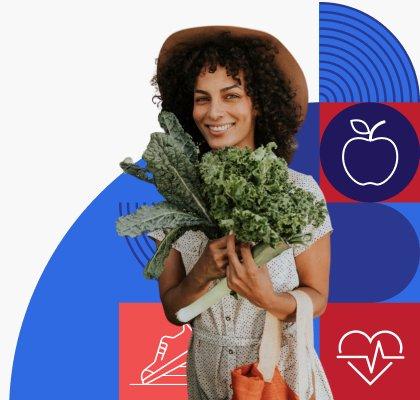Health Conditions
Heart-Healthy Foods: Shopping List

When it comes to your heart, what you eat matters. Follow these tips for heart-healthy eating:
- Eat less saturated fat. Cut back on fatty meats and high-fat dairy products. Limit foods like pizza, burgers, and creamy sauces or gravy.
- Cut down on sodium (salt). Read the Nutrition Facts label and choose foods that are lower in sodium. Look for foods labeled “low sodium” or “no salt added” — like some canned soups, canned vegetables, packaged meals, and snack foods.
- Get more fiber. Eat vegetables, fruits, beans, and whole grains to add fiber to your diet.
Take this list with you the next time you go food shopping.
Vegetables and Fruits
Eat a variety of vegetables and fruits — including options that are fresh, frozen, canned, or dried. Try:
- Fresh vegetables like tomatoes, cabbage, okra, edamame, and carrots
- Leafy greens like Romaine lettuce, spinach, bok choy, and kale
- Canned vegetables that are low in sodium
- Frozen vegetables without added butter or sauces, like broccoli or cauliflower
- Fresh fruits like apples, oranges, bananas, mangoes, guava, and papaya
- Canned, frozen, or dried fruit without added sugars
Farmers markets are great places to buy vegetables and fruits that are in season. Find a farmers market near you.
Dairy
Look for fat-free or low-fat options like:
- Fat-free or low-fat (1%) milk
- Fat-free or low-fat plain yogurt
- Fat-free or low-fat cheese or cottage cheese
- Fortified soy beverages (soy milk) or soy yogurt
Whole Grains
For products with more than 1 ingredient, make sure whole wheat or another whole grain is listed first in the ingredient list. Look for products that say 100% whole grain. You might try:
- Whole-grain bread, bagels, English muffins, and tortillas
- Whole-grain hot or cold breakfast cereals with no added sugar, like oatmeal or shredded wheat
- Whole grains like brown or wild rice, quinoa, or oats
- Whole-wheat or whole-grain pasta and couscous
Proteins
Choose a variety of foods with protein. Options include:
- Seafood — fish and shellfish
- Poultry — chicken or turkey breast without skin or lean ground chicken or turkey (at least 93% lean)
- Lean meats — like pork shoulder, beef sirloin, or lean ground beef (at least 93% lean)
- Beans, peas, and lentils — like black beans and garbanzo beans (chickpeas)
- Eggs
- Unsalted nuts, seeds, and nut butters — like almond or peanut butter
- Tofu
Healthy Fats and Oils
Replace saturated fat with foods that have healthier unsaturated fats — like seafood, nuts, seeds, avocados, and oils. Try these healthy swaps:
- Vegetable oil (canola, corn, olive, peanut, safflower, soybean, or sunflower) instead of butter for cooking
- Low-fat or light mayonnaise instead of full-fat mayo
- Oil-based salad dressings like balsamic vinaigrette or Italian instead of creamy dressings like ranch
Vegetable oils are usually healthy choices — just avoid coconut and palm oils, which are high in saturated fat. Some margarines and other soft spreads may have less saturated fat than butter — check the Nutrition Facts label and look for options with less saturated fat.
Content last updated September 19, 2023
Reviewer Information
This content on a heart-healthy diet was adapted from materials from the National Heart, Lung, and Blood Institute.
Reviewed by:
Kara Beckman, PhD
ORISE Nutrition Policy Fellow
Office of Disease Prevention and Health Promotion
Dana DeSilva
ORISE Nutrition Policy Fellow
Office of Disease Prevention and Health Promotion
Dennis Anderson-Villaluz, MBA, RD, LDN, FAND
Lieutenant Commander, U.S. Public Health Service
Nutrition Advisor, Division of Prevention Science
Office of Disease Prevention and Health Promotion


